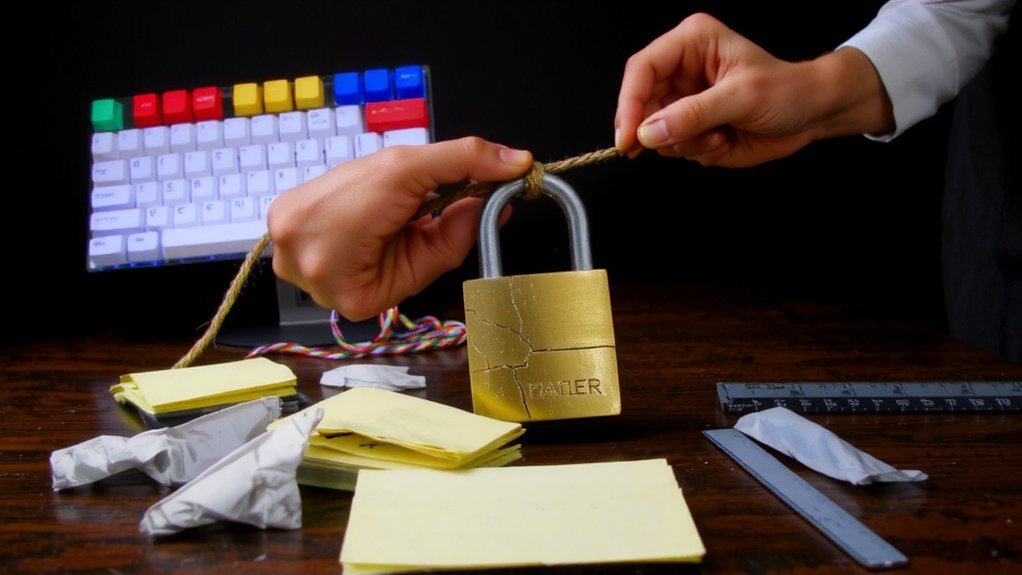You should use a strong password you can actually remember, not a jumble of symbols you’ll forget. Choose a long passphrase of unrelated words, add small consistent twists, and never reuse it across accounts. This reduces risk and makes management realistic—here’s how to build, store, and protect them.
Why Length Matters More Than Complexity

Because each extra character multiplies the number of possible passwords, adding length gives you far more protection than swapping in a few symbols, numbers, or capital letters.
You should prioritize longer secrets because attackers use brute-force and dictionary attacks that scale with total combinations, not the type of character you tacked on.
Each extra character adds entropy exponentially, so two extra characters often beat multiple complexity rules.
Don’t rely on common substitutions like “0” for “o” or “3” for “e”; they’re predictable.
Aim for a passphrase or password length that suits the threat — for most personal accounts, at least 12–16 characters reduces risk significantly.
Combine length with unique passwords per site and a reputable manager to store them securely and enable two-factor authentication.
Building Memorable Passphrases With Random Words

How can you make a password that’s both strong and easy to remember? Use a passphrase made from several truly random words you select or generate with a reputable word list.
Pick four to six unrelated nouns or verbs so the phrase has high entropy yet remains pronounceable. Avoid meaningful quotes or common phrases; randomness prevents targeted guessing.
Visualize a brief, silly scene linking the words — that mental image helps recall without writing it down. Consider using spaces or hyphens if the site allows, which improves readability.
Never reuse the passphrase across accounts, and generate new random phrases for important services. If you struggle to memorize one, store it securely in a password manager instead of simplifying the phrase and review backup options.
When and How to Use Character Variety

When a site forces specific rules or your passphrase is shorter than you’d like, add character variety to raise complexity without making it harder to remember.
Use a few targeted changes: mix uppercase and lowercase letters in a pattern you recall, insert numbers that mean something only to you, and add one or two symbols in fixed positions.
For sensitive accounts or sites that ban long phrases, favor longer substitutions over many small tweaks.
Apply the same transformation rule across related passwords so you can recall variations without copying exact strings.
Use a password manager to store fully randomized entries when you can’t design a memorable variant.
Test new passwords against strength meters, then update them periodically.
Rotate methods if an account’s risk increases.
Avoiding Common Pitfalls and Predictable Patterns

After using character variety to strengthen shorter passphrases, you still need to avoid obvious patterns attackers expect. Don’t reuse passwords across accounts; a breach on one site exposes others. Avoid sequences and repeated characters like “12345”, “abcdef”, “0000”, or “qwerty”.
Skip common substitutions such as “P@ssw0rd” or predictable year numbers. Don’t base passwords on names, birthdays, or public info you share on social media.
Resist using obvious modifications when forced to change a password — adding “1” or incrementing a number is predictable. Use unique, unrelated passwords for each account and consider randomized passphrases or a reputable password manager to generate and store them.
Regularly review and replace weak or reused credentials to limit exposure. Make security-question answers as random and unrelated as possible.
Protecting Against Phishing and Keyloggers

Why let attackers capture your credentials when you can block their tricks?
You should scrutinize emails and messages: don’t click unexpected links or open attachments, hover to check URLs, and confirm requests by contacting the sender through a known channel.
Use unique, strong passwords per account and enable two-factor authentication so stolen passwords alone won’t gain access.
Keep your operating system, browser, and security software updated to close exploits attackers use to deploy keyloggers.
Only install apps from trusted sources and avoid running unknown executables.
On public Wi‑Fi avoid logging into important accounts without a VPN.
Regularly scan your device with anti-malware tools and remove suspicious software.
If you notice odd behavior—slow performance, unexpected prompts—disconnect, scan, and change affected passwords from a clean device.
Using Password Managers Safely
How do you pick and use a password manager safely?
Choose a reputable manager with strong end-to-end encryption, regular updates, and transparent security practices.
Use a long, unique master password you can’t reuse elsewhere and enable device-level protection (screen lock, biometrics).
Keep apps, browser extensions, and operating systems current.
Limit autofill to trusted sites; disable it on unfamiliar pages and for sensitive forms.
Back up your vault securely—prefer encrypted exports stored offline—and avoid sharing master credentials.
Prefer managers with recovery options you understand, and review permissions before installing extensions.
Verify downloads from official sites or app stores, and read recent security audits and community feedback.
If a compromise appears, change affected account passwords immediately.
Audit your vault and remove outdated entries you don’t need.
Enabling Multi-Factor Authentication and Passkeys
Lock down your accounts by enabling multi-factor authentication (MFA) and switching to passkeys when available.
MFA adds a second proof—like a short-lived code, authenticator app prompt, or security key—so a stolen password alone won’t grant access.
Use an authenticator app or hardware token for higher security; SMS is better than nothing but vulnerable to SIM attacks.
Passkeys replace passwords with cryptographic credentials tied to your device; they’re phishing-resistant and simplify sign-in.
When a service offers passkeys, opt in and register them on each device you use.
Keep biometric or device PIN protections enabled so passkeys stay secure locally.
Together, MFA and passkeys dramatically reduce account compromise risk without making daily access cumbersome.
Review supported methods and choose options that balance security and convenience daily.
Managing Recovery Options and Routine Updates
Regularly review and update your account recovery options so you can regain access quickly if something goes wrong.
Check that your recovery email and phone number are current, remove old devices, and add a trusted secondary contact.
Use an authenticator app or hardware key where supported, and back up passkeys to a secure location.
Store recovery codes in a password manager or a locked physical place, not in plain text on devices.
Schedule periodic reviews—every six months—or after major changes like new devices or travel.
When you change passwords, update stored credentials in your manager immediately.
Revoke access for lost or unused devices and monitor account alerts; prompt action minimizes exposure and keeps your accounts recoverable and secure.
Test recovery flow annually to confirm.
Conclusion
You’ll create stronger, more usable passwords by choosing long passphrases of random words, adding minimal, memorable character swaps, and keeping a consistent case or symbol pattern when required. Don’t reuse passwords; store unique ones in a reputable password manager and back up encrypted vaults securely. Enable multi‑factor authentication or passkeys for important accounts, review recovery options, and replace compromised passwords promptly to stay protected against phishing and keyloggers, and update weak passwords on a schedule.